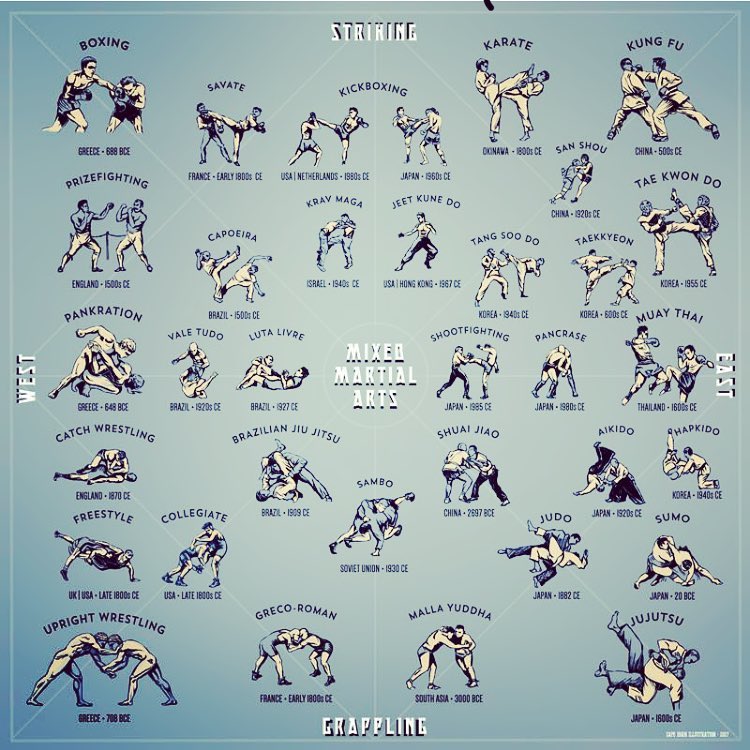Exploring The Rich Heritage And Spiritual Capacities Of Fighting Style: A Comprehensive Exam
Exploring The Rich Heritage And Spiritual Capacities Of Fighting Style: A Comprehensive Exam
Blog Article
Content Create By-McGrath Stokes
Enter the old globe where martial arts were substantiated of necessity in diverse regions. Societies crafted one-of-a-kind battling designs intertwined with historical contexts. Techniques advanced over centuries with committed practice and social exchanges. Today, modern martial arts mix standard aspects for maximum efficiency. Philosophically, martial arts highlight discipline, self-improvement, and harmony. Respect, humility, and equilibrium are fundamental principles assisting professionals in the direction of growth and durability. Explore the midsts of this abundant history and approach to uncover the profound impacts shaping this enduring self-control.
Origins of Martial Arts
Martial arts originated in various regions worldwide, progressing as sensible combat systems to resist dangers. These old fighting styles were established out of necessity, with each culture crafting strategies fit to their distinct atmospheres and challenges. From the grappling arts of Jujutsu in Japan to the striking strategies of Kung Fu in China, martial arts were deeply intertwined with the historical, social, and social material of their respective cultures.
In Japan, the samurai course refined martial arts like Kenjutsu, the art of the sword, which later on advanced into the extra promoted form of Kendo. Meanwhile, in Brazil, Capoeira became a mix of dancing and battle, created by enslaved Africans as a way to stand up to fascism. Each martial art carries with it a rich background and ideology, mirroring the values and ideas of the people that practiced them.
As Read More In this article look into the beginnings of martial arts, you discover a tapestry of human ingenuity, resilience, and the unyielding spirit of warriors throughout time.
Advancement of Strategies
With centuries of method and refinement, combat techniques within various martial arts have undergone a profound evolution. From ancient styles like Kung Fu and Karate to much more modern-day disciplines such as Brazilian Jiu-Jitsu and Krav Maga, the evolution of techniques has been driven by a combination of cultural influences, sensible applications, and technological improvements.
One considerable aspect of this advancement is the cross-pollination of techniques between various martial arts. As an example, techniques from traditional Japanese Jiu-Jitsu were incorporated right into the development of Judo by Jigoro Kano in the late 19th century. This mixing of designs has led to the advancement of hybrid martial arts like Mixed Martial Arts (MIXED MARTIAL ARTS), which combine components of striking, grappling, and submission strategies.
Moreover, what do martial arts lessons cost for kids of methods has been shaped by the increasing focus on effectiveness and performance in fight. Practitioners have actually constantly looked for to fine-tune their strategies through extensive training, trial and error, and competitors, leading to the advancement of extremely specialized and efficient fighting designs. Overall, the development of methods in martial arts shows the dynamic nature of combat and the ongoing pursuit for enhancement and technology.
Philosophical Foundations
Checking out the underlying philosophical principles of martial arts supplies insight into their core worths and leading beliefs. At the heart of numerous martial arts self-controls is the principle of discipline itself. By training your body and mind to serve as one natural unit, you cultivate technique that expands past the dojo or health club into everyday life. This discipline includes respect, humility, and self-constraint, forming not just your physical capabilities yet also your personality.
One more essential philosophical foundation in martial arts is the idea of constant self-improvement. The trip of understanding a martial art is never-ending, with practitioners frequently making every effort to far better themselves, both physically and mentally. This concentrate on growth fosters durability, perseverance, and a development frame of mind that can be related to all elements of life.
Additionally, martial arts stress the importance of harmony and balance. Techniques are created to make use of a challenger's energy versus them, highlighting the principle of generating and rerouting force as opposed to satisfying it head-on. This viewpoint reaches interpersonal partnerships, advertising tranquil resolutions and mutual understanding. By welcoming these thoughtful foundations, martial artists not just improve their battle skills however also cultivate a lifestyle fixated personal growth, regard, and harmony.
Conclusion
Finally, the history and philosophy of martial arts provide an abundant tapestry of practice, technique, and self-improvement.
Take for instance the story of Bruce Lee, who transformed martial arts by mixing different styles and viewpoints to develop his own special type of Jeet Kune Do.
With commitment and technology, martial musicians continue to push limits and inspire others to reach their full capacity both in fight and in life.
